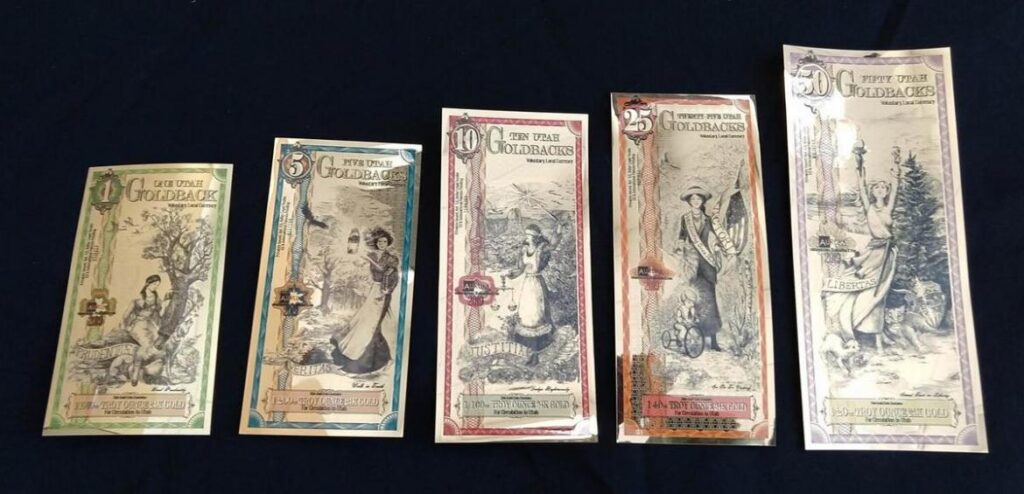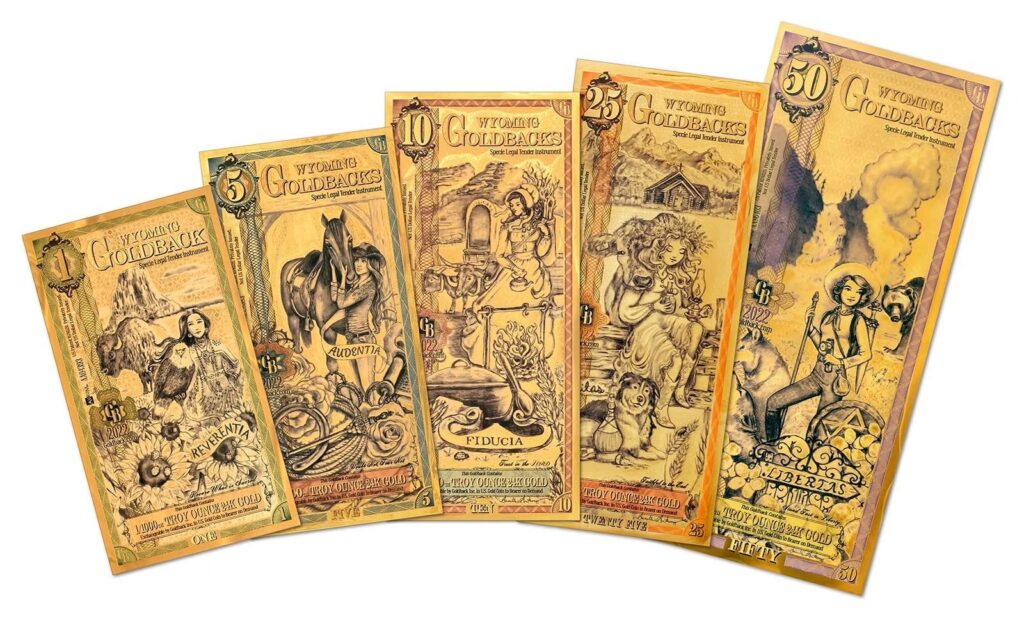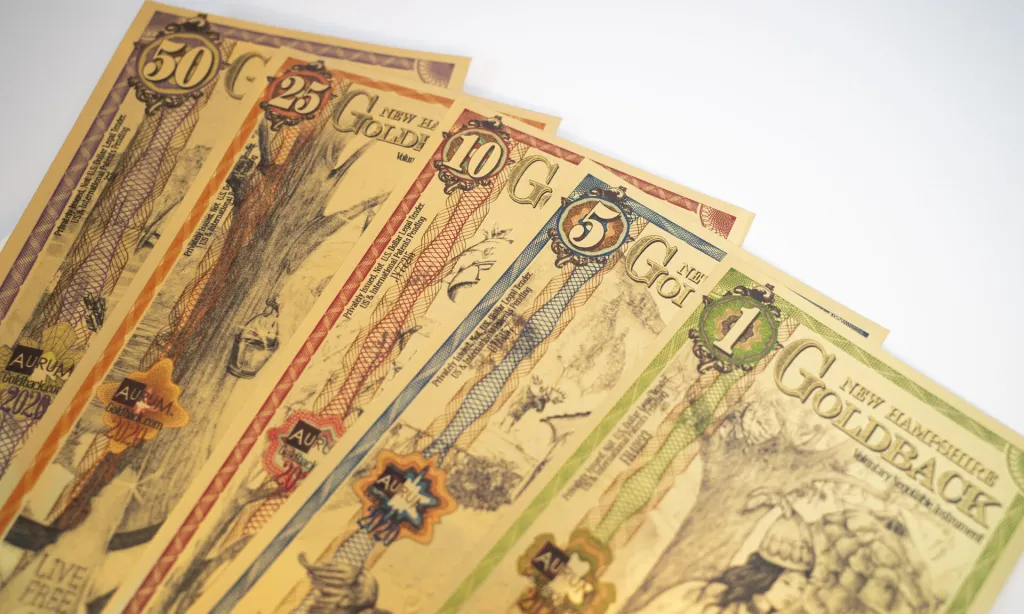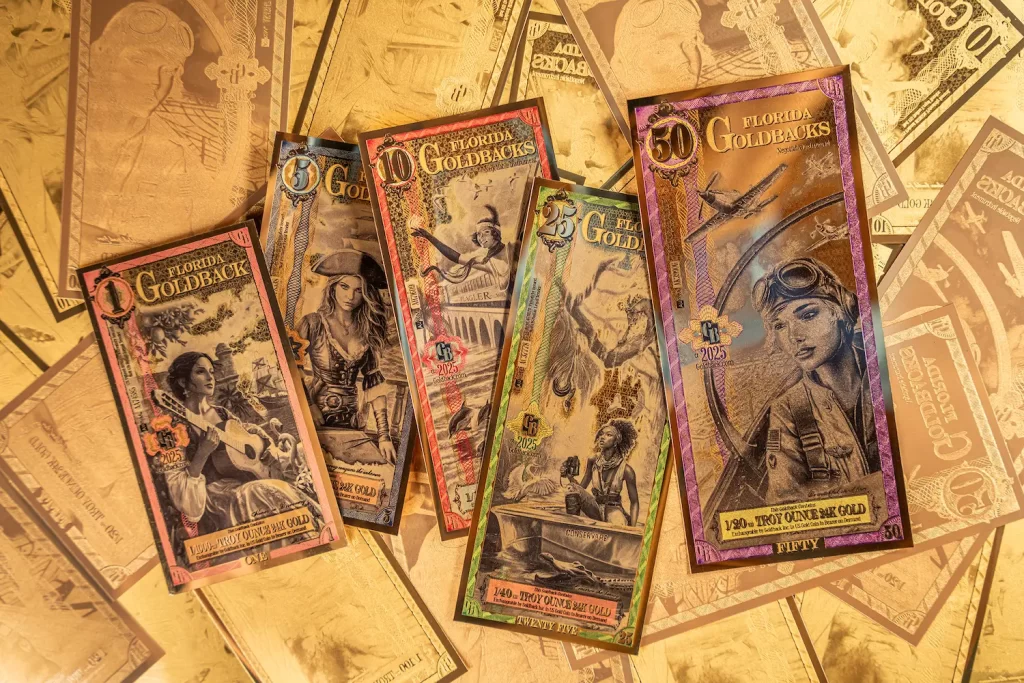Table of Contents
A Modern Blend of Precious Metal and Practical Spending
Traditional currencies lose value over time, especially during inflation, but physical gold maintains purchasing power. A new type of currency bridges the gap between gold’s reliability and the convenience of cash by embedding pure 24-karat gold directly into flexible notes. Each one contains a specific fraction of a troy ounce—such as 1/1,000th or 1/20th—making it possible to carry and spend real value in everyday life. This innovation offers the strength of sound money in a form that’s divisible, portable, and beautifully designed. Only one such example exists on the market today: goldbacks, a true evolution of physical currency.
Unlike traditional gold bars or coins typically locked away as long-term assets, these notes are designed for practical use. They can be carried like regular cash and are ideal for people who want the stability of precious metals without sacrificing convenience. Artistic illustrations on each note depict themes like Liberty and Prudence, giving them cultural and aesthetic value beyond their monetary worth. With the actual metal visible inside each note, they serve as a transparent alternative to fiat systems backed by trust alone. Goldbacks provide a tangible, elegant solution for those seeking both security and everyday usability.
Reviving Precious Metals for Everyday Exchange
As inflation and economic uncertainty rise, interest in returning to tangible forms of money is growing. Modern paper and digital currencies lack the intrinsic value of precious metals, which have served as trusted mediums of exchange for centuries. In 2019, a new form of gold-infused currency launched in Utah, offering an alternative rooted in sound money principles. This innovation quickly expanded to states like Nevada, New Hampshire, and Florida, with each version featuring original artwork tied to local culture and values. By embedding real gold into flexible notes, goldbacks present a bold, decentralized return to everyday transactions backed by something real.
Instead of waiting for government recognition, this currency spread through voluntary acceptance. Creators partnered directly with local merchants, forming a free-market ecosystem where notes could be used without legal mandates. This grassroots model encourages trust and slow adoption, avoiding the pitfalls of forced economic systems. Each state’s series offers not just a medium of exchange, but a celebration of its heritage, combining artistic beauty with economic utility. Unlike centralized banking systems that print value out of thin air, goldbacks revive the concept of wealth you can hold, see, and spend—offering communities a practical step back to monetary principles that once built nations.
High-Tech Craftsmanship Meets Monetary Innovation
Creating spendable notes from pure gold requires cutting-edge methods not used in typical coin or bullion production. Through vacuum deposition, 24-karat gold is vaporized into a plasma state and deposited onto a clear polyester film with microscopic precision. This atomized gold layer is then sandwiched between two transparent polymer sheets that protect the metal while allowing detailed artwork to be visible. The result is a flexible, tamper-resistant note that merges durability with elegance. Thanks to this advanced layering technique, goldbacks can be bent or folded without harming the integrity of the embedded gold, setting them apart from traditional forms of gold storage.
The encapsulation process not only safeguards the gold from wear but also makes the note highly resistant to environmental damage. The non-reactive nature of gold helps, but the added polymers ensure long-term preservation against oxidation or friction. Each piece is engineered to a tight standard, often within 1% accuracy, and typically contains slightly more gold than the weight listed. This meticulous attention to consistency builds trust among users and collectors. The fusion of science and design allows goldbacks to function as both a practical currency and a visually striking form of art, marrying precision engineering with monetary value.
Advanced Design Features That Protect Real Value
Modern counterfeiting methods require modern defenses, and this currency answers the challenge with layered, high-tech protection. One standout feature is the “ghosted” image printed in reverse and raised on the back of each note, offering a tactile and visual cue that’s difficult to fake. A mirrored serial number appears when the note is held to light, providing immediate verification. These elements are more than aesthetic—they’re functional, built to stop fraud in its tracks. This type of multi-layer authentication gives confidence to both consumers and merchants who accept goldbacks, helping the currency stand apart as a trusted form of tangible value.
Additional safeguards include UV-reactive inks that reveal hidden patterns under blacklight and microprinted text so fine it’s only legible under magnification. These advanced features work together to create a note that’s nearly impossible to duplicate without specialized equipment. Each serial number is unique and traceable, allowing users to confirm authenticity if needed. This robust security system plays a vital role in building trust in the currency’s reliability, especially in a world where printed money can be easily forged. Even if damaged, goldbacks retain their intrinsic worth, offering more than aesthetics—they represent a secure, verifiable store of wealth.
Trusted Testing Methods That Confirm True Gold Purity
Maintaining precise gold weight in every note begins with automated oversight. During the production phase, computerized sensors track the gold as it’s applied in real time, ensuring the layer maintains uniform thickness. These sensors are programmed to adjust continuously, creating a consistent, ultra-thin sheet of metal that is accurate down to microscopic measurements. Most notes are designed to slightly exceed the minimum required gold content, adding a layer of consumer confidence. This kind of attention to detail helps reinforce public trust and aligns with practices used by high-standard mints. From start to finish, goldbacks are built to strict technical specifications, tested from the first layer onward.
After production, quality assurance doesn’t stop—it intensifies. Select notes from each batch are randomly pulled for deeper inspection using non-destructive X-ray fluorescence. This advanced method detects the elemental makeup without altering the product. In addition, fire assays are used, melting down sample pieces to verify exact gold content through chemical analysis. These are the same techniques applied to bullion bars and coins, reinforcing the legitimacy of every piece. Goldbacks consistently test at 99.99% pure gold, aligning them with industry gold purity standards. This rigorous process proves they’re not just decorative—they’re engineered to hold verifiable, intrinsic value.

Fractional Gold That Fits Every Transaction Size
Creating currency from gold typically limits flexibility, but this system solves that by offering multiple denominations. Notes are available in 1, 5, 10, 25, and 50 units, with each step up increasing the gold content proportionally. For example, the smallest note holds 1/1,000th of a troy ounce, while the largest carries 1/20th. This range allows users to conduct both small and large transactions without needing to break or melt physical metal. Unlike traditional gold coins, which are harder to divide without losing material or value, goldbacks provide fractional gold with the ease of cash—ready to use, carry, or save based on daily needs.
The pricing for each note includes a built-in premium that reflects production, artwork, and security measures. However, the larger the denomination, the lower the cost per unit of gold. For instance, purchasing one 50-unit note is more cost-effective than buying fifty 1-unit notes, making higher denominations ideal for those focused on long-term value. This structure encourages both everyday spending and strategic stacking. Unlike fiat currency that erodes over time, each goldback is tied to the intrinsic value of gold itself, offering users a stable and inflation-resistant way to store purchasing power without compromising liquidity.
Understanding Value Beyond the Spot Price
Each note’s pricing starts with the spot price of gold but must also include added costs for its detailed production process. Because the gold is measured in tiny fractions—down to 1/1,000th of a troy ounce—manufacturing requires extreme precision. This complexity adds a necessary premium, reflecting not only the gold itself but also the specialized equipment, labor, and artwork involved. As a result, the average exchange rate for a single unit ranges from $3.50 to $4.00. On collector markets, prices may rise further depending on rarity or state-specific editions. These notes aren’t just priced on raw material—they’re valued for their intricate build and real-world usability, like goldbacks.
The smaller the gold unit, the more expensive it becomes per ounce due to handling and material loss risks during production. This is why bullion bars and large coins often appear cheaper by weight. However, they lack flexibility in everyday transactions. These fractional notes, although priced higher per ounce, offer unmatched utility. They function not just as a store of value, but also as a means of direct trade. As the gold market grows, so does the embedded worth of each note, allowing goldbacks to keep pace with inflation while offering more versatility than traditional bullion.
Real Spending Power Rooted in Tangible Value
Far from being collector-only items, these notes are actively used for purchases in day-to-day commerce. In places like Utah, Nevada, and New Hampshire, small businesses across industries—from coffee shops to auto repair garages—now accept them as valid payment. Over 1,000 merchants have joined the network, voluntarily choosing to accept this form of money because it carries intrinsic value. By treating the notes as real assets rather than speculative tools, businesses strengthen local economies through trust and tangible value. One unit might buy a cup of coffee, while higher denominations can cover service work, proving that goldbacks can function in real-time spending environments.
This form of currency offers buyers the familiarity of cash transactions with the added assurance of holding real gold. The embedded metal provides lasting value, which traditional bills lack. As more consumers recognize this benefit, an online marketplace has emerged where these notes are also bought, sold, and traded peer-to-peer. That digital layer further increases their utility and accessibility. Unlike fiat money that erodes in value, goldbacks maintain purchasing power over time, making them attractive for both spending and saving. Their use in modern commerce challenges the outdated belief that gold is too heavy or rare to be practical.

A Fusion of Art, Allegory, and Regional Pride
Each series produced showcases five original designs, carefully crafted to match the denomination and cultural spirit of its issuing state. These illustrations aren’t random—they’re packed with historical and symbolic meaning. For example, Utah’s depiction of “Prudence” highlights self-reliance with imagery of a woman harvesting wheat, while New Hampshire’s “Libertas” draws directly from Revolutionary War themes. The figures, attire, and symbols reflect local heritage and values, elevating these notes into something more than currency. With their detailed allegories and rich iconography, goldbacks stand as modern artifacts—bridging the practical function of money with the emotional resonance of cultural storytelling.
Collectors and users alike value these notes not just for what they’re worth, but for what they represent. Artists design each piece to capture ideals like freedom, stewardship, and justice—virtues often overlooked in standard currency design. This artistic layer fosters a unique emotional connection, allowing the holder to view their money as both meaningful and beautiful. Unlike disposable cash, these notes are often displayed, saved, or even framed, becoming family keepsakes passed from one generation to the next. That cultural and emotional relevance sets goldbacks apart as a form of currency that doubles as enduring, tangible art.
Turning Gold from Storage to Circulation
For centuries, gold has played a prominent role in wealth preservation, but rarely in everyday spending. It’s been shaped into coins like the American Eagle or Krugerrand, worn as jewelry, or stored as bullion in vaults. While these forms hold long-term value, they aren’t practical for day-to-day transactions due to weight, risk, and verification issues. Attempting to spend a coin requires precise scales or expertise to confirm authenticity. A modern solution has emerged that standardizes gold in small, convenient units with built-in security features—making goldbacks a functional currency. They mark a departure from storing value to actually spending it without compromising trust or ease.
Past systems like gold certificates promised a fixed value but were backed by centralized institutions that could revoke or change policies. What sets this approach apart is the presence of actual gold embedded in each unit—no redemption required. Users hold the physical asset in a lightweight, spendable form. It transforms the perception of gold from a static investment into a tool for commerce. While bullion still thrives in long-term portfolios, goldbacks have opened a door for practical, everyday use, proving that precious metals can adapt to modern needs while retaining their timeless value.

Addressing Price Premiums and Public Perception
One of the most cited concerns is the premium added to each unit compared to raw bullion. Investors often argue that they can acquire more gold by purchasing traditional bars or coins without the extra cost tied to manufacturing. However, this comparison overlooks key factors like portability, divisibility, and real-world utility. The production cost reflects more than gold—it includes specialized technology, design, and security features. While traditional bullion is ideal for storage, goldbacks are designed for spending. Their premium isn’t simply a markup; it supports a unique form of currency that fills a different role in the gold economy and offers flexibility unavailable in bulk metals.
Another barrier is widespread recognition. Many people still don’t realize that physical gold can be used outside of investment portfolios. Confusion sometimes arises, with some mistaking these notes for vouchers or certificates instead of actual gold. Public education is essential to clear up these misunderstandings and showcase real use cases. When merchants and customers share positive experiences, it helps normalize acceptance. Community-level adoption is key—once people see these notes working in everyday settings, trust grows. As more regions embrace goldbacks in commerce, confidence in their practicality and purpose is likely to expand alongside usage.
Bridging Tradition and Innovation in Modern Currency
As faith in fiat currencies continues to erode, demand for stable, tangible alternatives is rising. This growing sentiment has fueled efforts to expand new forms of gold-based money into additional states, broadening regional access and boosting circulation. New designs tailored to local culture, along with expanded merchant networks, are strengthening the foundation for broader adoption. Future enhancements could include smartphone integrations, like QR-code-based transactions, bringing real gold into the digital economy. These developments show a clear effort to modernize while preserving the asset’s physical nature. For many users, goldbacks represent more than currency—they’re a statement about financial independence and lasting value.
Their role in modern finance may evolve, but their core contribution is already significant. By reintroducing gold in a practical and artistic form, these notes challenge the dominance of centralized, trust-based currencies. Their hybrid model—part analog, part high-tech—offers a blueprint for future monetary systems that prioritize security, value, and usability. Whether adopted nationwide or embraced by smaller communities, goldbacks have already cemented a place in the history of alternative finance. As they continue to grow, their influence may extend far beyond commerce, reshaping how society views money, ownership, and economic freedom in a rapidly changing world.
How useful was this post?
Click on a star to rate it!
Average rating / 5. Vote count:
No votes so far! Be the first to rate this post.
Author
-
Meet Dr. Kendall Gregory, a highly accomplished professional with a remarkable academic background and a deep passion for empowering individuals through knowledge. Dr. Gregory’s educational journey began with a Bachelor of Science degree, followed by a Doctor of Chiropractic Medicine, focusing on diagnosing and treating musculoskeletal conditions. He further expanded his expertise with a Master's degree in Oriental Medicine, specializing in acupuncture and Chinese herbology, and a Master's degree in Health Care Administration, emphasizing his dedication to improving healthcare systems. Dr. Gregory combines his extensive knowledge and practical experience to provide comprehensive and integrative healthcare solutions. Through his writings, he aims to inspire individuals to take charge of their health and make informed decisions.
View all posts







